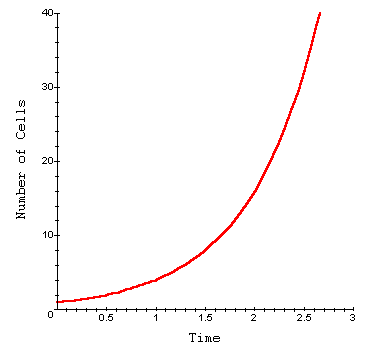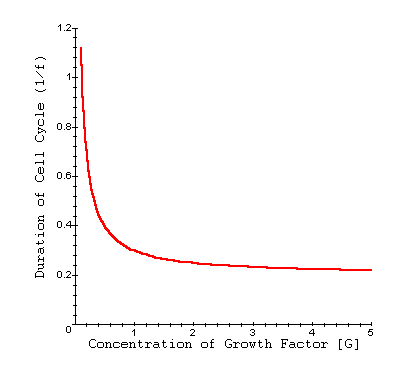
CELL DIVISION IN THE PRESENCE OF A GROWTH FACTOR
Introduction: Under optimal conditions, growth of cells occurs as each cell completes the cell cycle and doubles producing two daughter cells which later themselves divide. Growth factors can provoke the growth of cells. For example, interleukins are made by white blood cells to stimulate the growth of other immune system cells. Erythropoietin is made by the kidney to promote growth of red blood cells.
Importance: We can use equations to determine how the growth factor affects the rate of cell growth.
Question: How do growth factors affect the rate at which cell populations grow?
Variables:
|
Nt |
number of cells in the population |
|
N0 |
number of cells initially |
|
f |
frequency of cell cycles per unit time (1/hour) |
|
t |
time (hour) |
|
fmax |
maximum cell cycle frequency (1/hour) |
|
c |
constant (hour x mg/mL) |
|
[G] |
concentration of growth factor (mg/mL) |
Methods: The growth of cells is often described exponentially (one cell becomes two cells become four cells become eight cells...). This can be described mathematically by the following equation:

where Nt is the number of cells at time t, N0 is the number of cells initially, and f is the frequency of cell cycles per unit time. For example if a cell completes the cell cycle two times an hour, then f=2 cell cycles per hour. Similarly we can write the duration of the cell cycle as 1/f, or number of hours per cell cycle. If f=2, then the duration of the cell cycle is 1/2 hour.

In the presence of a growth factor, the frequency of cell cycles may be increased. However, because growth factor receptors in the cell membrane may become saturated at high concentrations of growth factor, the cell growth rate cannot increase infinitely.
We can utilize Michaelis-Menten and Lineweaver-Burk equations to describe the duration of the cell cycle (1/f) as a function of the concentration of the growth medium [G] using the following equation:

where fmax is the maximum frequency of cell division when [G] is very large and c is a constant relating the intensity with which the growth factor increases cell division. We can plot 1/f as a function of [G] to examine how the growth factor concentration affects the duration of the cell cycle. Take c = 0.1 hours (mg/mL) and fmax = 5 cell cycles/hour.

Interpretation: Even at relatively low concentrations of a growth factor, the duration of the cell cycle can rapidly decrease. This results in a higher freqency of cell divisions per unit time. As the concentration of growth factor increases however, the duration of the cell cycle eventually levels off, and the frequency of cell divisions cannot increase further.
Conclusions: The presence of a growth factor can greatly increase the rate at which a cell population grows. By quantifying this with simple equations, we can experimentally determine the maximum frequency of cell division for a population as well as the speed with which a growth factor helps the cells reach that maximum frequency.
Additional Questions:
1. Look at the equation for 1/f. What is the cell duration as [G] goes to infinity?
2. Graph f as a function of [G]. How does the interpretation of this graph compare to that of the function 1/f? What other biological processes is this function similar to?
3. How does the exponential growth of the population (the function Nt) change as the growth factor concentration [G] increases? Graph Nt as a function of time for several values of f.
Source: Chen, C. and S. C. Chen. 1981. Cell growth factor activity: New quantitative method in cell culture assay. Experimental Cell Research 136:43-51
Copyright 1999 M. Beals, L. Gross, S. Harrell